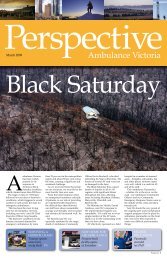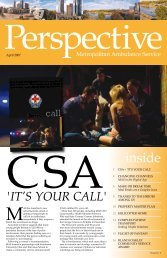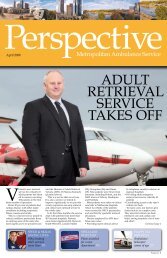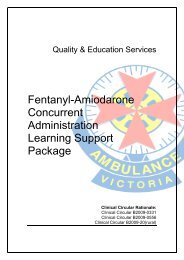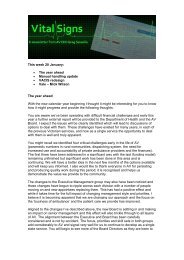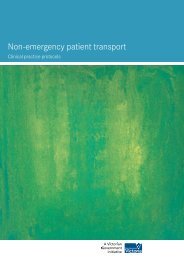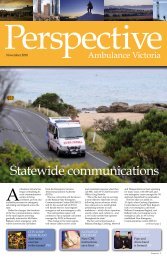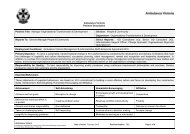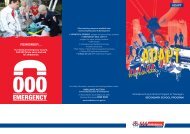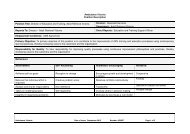VACAR Annual Report 2011/12 - Ambulance Victoria
VACAR Annual Report 2011/12 - Ambulance Victoria
VACAR Annual Report 2011/12 - Ambulance Victoria
Create successful ePaper yourself
Turn your PDF publications into a flip-book with our unique Google optimized e-Paper software.
Executive summary<br />
1. There were 5,<strong>12</strong>4 adult OHCA events in the period between 1 July <strong>2011</strong> to 30 June 20<strong>12</strong>,<br />
with 9% of these events witnessed and monitored by paramedics. Of the events not<br />
witnessed by EMS, 46% of patients received an attempt at resuscitation by paramedics<br />
and/or first responders. Significantly fewer events are observed in peoples aged less than 16<br />
years, with 101 recorded over the <strong>2011</strong>/<strong>12</strong> period. The incidence of OHCA was higher in the<br />
rural region than in the metropolitan region: 1<strong>12</strong>.2 versus 87.6 events per 100,000 people<br />
(see ‘Incidence & demographics’, page 20).<br />
2. In <strong>2011</strong>/<strong>12</strong>, 70% of all OHCA events were presumed to be of cardiac aetiology, with trauma,<br />
respiratory, terminal illness, and hangings being predominately responsible for the<br />
remaining causes of arrest. The median age of adult OHCA was 69 years, with two thirds<br />
of events involving males. Of the adults receiving an attempt at resuscitation, 23%<br />
occurred in a public place. For cases involving paediatrics (aged less than 16 years), the<br />
medium age was 1 year, males represented 66% of cases, with SIDS as the perceived cause<br />
of arrest in the majority of cases (see ‘Incidence & demographics’, page 20).<br />
3. Emergency call-takers are effective at identifying cardiac arrest events during the<br />
emergency call, with 91% being correctly identified in the metropolitan region. Early<br />
access, early CPR and early defibrillation play a critical role in survival from OHCA. In<br />
<strong>2011</strong>/<strong>12</strong>, first responders including fire-services and community emergency response teams<br />
arrived on scene prior to <strong>Ambulance</strong> paramedics in over a quarter of cases. Importantly,<br />
defibrillation by first responders or public AED for patients presenting in a shockable<br />
rhythm resulted in an increase in survival to hospital discharge. Of the events witnessed<br />
by bystanders and in whom resuscitation was attempted, 70% received CPR by a member<br />
of the public (see ‘Systems of care’, page 32).<br />
4. The initial rhythm on presentation of EMS provides valuable prognostic information. Of<br />
the cases receiving an attempt at resuscitation, 30% of patients presenting in a shockable<br />
rhythm survived to hospital discharge. Asystole and pulseless electrical activity were<br />
associated with poorest survival to discharge, with 0.3% and 4% respectively. Return of<br />
spontaneous circulation outcomes have increased sustainably since 2005/06, from 36% to<br />
49% of all adult bystander witnessed cases receiving an attempted resuscitation in <strong>2011</strong>/<strong>12</strong><br />
(see ‘Survival outcomes’, page 40).<br />
5. Survival from OHCA continues to improve in <strong>Victoria</strong>. In <strong>2011</strong>/<strong>12</strong>, adult OHCA from all<br />
aetiologies observed a 32% survival to hospital and 11% survival to hospital discharge rate.<br />
Adult patients presenting in a shockable rhythm fair significantly better, with 52%<br />
surviving to hospital and 30% surviving to hospital discharge. Patients who are witnessed<br />
to arrest by paramedics observe the greatest survival benefit with 67% surviving to<br />
hospital discharge. The majority of cases with known survival continue to be discharged<br />
home, or 85% in the <strong>2011</strong>/<strong>12</strong> reporting year (see ‘Survival outcomes, page 40).<br />
6. The risk-adjusted odds of survival to hospital discharge have improved significantly over<br />
the last 10 years. The probability of survival is 2.5 times higher in <strong>2011</strong>/<strong>12</strong> than cases in<br />
2002/03. This improvement is best observed in cases presenting in a shockable rhythm<br />
where the risk-adjusted odds of survival was 3.7 when compared with survival in 2002-03.<br />
Variation in the risk-adjusted odds of adult survival to hospital discharge was also<br />
observed across regions of <strong>Victoria</strong>, although this finding did not reach statistical<br />
significance (see ‘Survival outcomes’, page 40).<br />
<strong>VACAR</strong> <strong>Annual</strong> <strong>Report</strong> <strong>2011</strong>/<strong>12</strong> Page 19





